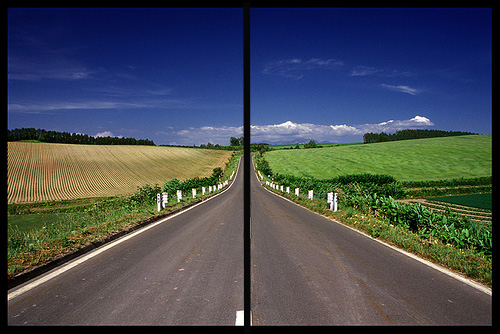Symmetric (Balanced) and Asymmetric (Unbalanced) Images
Symmetric Images
A common element of composition is related around SYMMETRY. If you are asking yourself what this is, simply look at this image:

The SYMMETRICAL image of this tree is EVEN from both sides of the vertical (up and down) center line creating a mirror image on both sides of the line. This is a simple image, but if you are viewing advanced photographic images it can be pleasing to the viewers eye. Below is an example of an image that follows vertical and horizontal symmetry (the same from side to side AND from up and down). Look at the lines drawn in from right to left and top to bottom in the second image. This shows this as a symmetrical shot.
This image is special as the photographer found a reflection and could show the image inverted (upside down) as well as from left to right, so the symmetry has two dimensions (both vertical and horizontal).


This image below only has one dimension of symmetry. The vertical line (up and down) shows how the photographer balanced the two sides of the road evenly to clearly demonstrate the road as the subject and how long the road flows away into the horizon.


Asymmetric Images

The image of this tree with the sides on either side of the vertical line unalike is called ASYMMETICAL. Both sides are not the same. Once again, this is a simple image and it makes it clear to the viewer and it makes the odd side stand out (which can be effective, like breaking a pattern in an image to make it stand out). Any image that is not "EVEN" or is off-center, is considered ASYMMETICAL. Any image that follows the RULE OF THIRDS, as we discussed in Term One, is considered asymmetic, as it is not CENTERED.
Examples using RULE OF THIRDS and are assymmetrical:



So what is the rule considering photography composition? Should you create an image that follows the rule of thirds and have an ASYMMETRIC appeal or should you create an image that is SYMMETRICAL and perfectly balance? Well there is no one correct answer! Sorry! It is up to the photographer to decide in her/his artistic judgement. But a safe bet is to use the following Strategy: THE TWO SHOT STRATEGY.
Good luck thinking about this element in photo composition! Look a little closer at how you balance your photos for the remainder of the semester!






Comments (0)
You don't have permission to comment on this page.